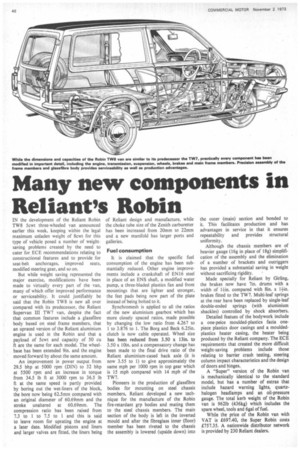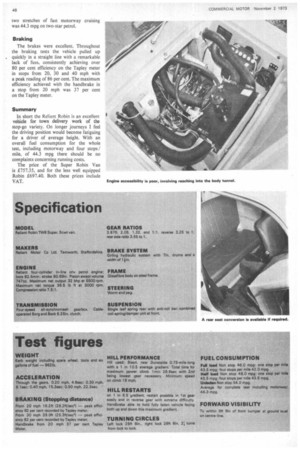Many new components in Reliant's Robin
Page 48

Page 49

Page 50

If you've noticed an error in this article please click here to report it so we can fix it.
IN the development of the Reliant Robin TW8 5cwt three-wheeled van announced earlier this week, keeping within the legal maximum unladen weight of 8cwt for this type of vehicle posed a number of weightsaving problems created by the need to cater for ECE recommendations relating to constructional features and to provide for seat-belt anchorages, improved seats, modified steering gear, and so on.
But while weight saving represented the major exercise, modifications have been made CO virtually every part of the van, many of which offer improved performance or serviceability. It could justifiably be said that the Robin TW8 is new all over compared with its predecessor, the Reliant Supervan III TW7 van, despite the fact that common features include a glassfibre body based on steel frame members, that an uprated version of the Reliant aluminium engine is used in the Robin and that a payload of 5cwt and capacity of 50 cu ft are the same for each model. The wheelbase has been extended 9in. and the engine moved forward by about the same amount.
An improvement in power output from 29.5 bhp at 5000 rpm (DIN) to 32 bhp at 5500 rpm and an increase in torque from 34.5 lb ft at 3000 rpm to 36.5 lb ft at the same speed is partly provided by boring out the wet-liners of the block, the bore now being 62.5mm compared with an original diameter of 60.69mm and the stroke unaltered at 60.69mm. The compression ratio has been raised from 7.3 to 1 to 7.5 to 1 and this is said to leave room for uprating the engine at a later date. Modified pistons and liners and larger valves are fitted, the liners being of Reliant design and manufacture, while the choke tube size of the Zenith carburetter has been increased from 20mm to 22mm and a new manifold has larger ports and galleries.
Fuel consumption It is claimed that the specific fuel consumption of the engine has been substantially reduced. Other engine improvements include a crankshaft of EN16 steel in place of an ENS shaft, a modified water pump, a three-bladed plastics fan and front mountings that are lighter and stronger, the feet pads being now part of the plate instead of being bolted to it.
Synchromesh is applied to all the ratios of the new aluminium gearbox which has more closely spaced ratios, made possible by changing the low ratio from 4.267 to 1 to 3.876 to I. The Borg and Beck 6.25in. clutch is now cable operated. Wheel size has been reduced from 3.50 x 13in. to 3.50 x 10in, and a compensatory change has been made to the final drive ratio of the Reliant aluminium-cased back axle (it is now 3.55 to 1) to give approximately the same mph per 1000 rpm in top gear which is 15 mph compared with 14 mph of the TW7.
Pioneers in the production of glassfibre bodies for mounting on steel chassis members, Reliant developed a new technique for the manufacture of the Robin fire-retardant grp bodies and mating them to the steel chassis members. The main section of the body is left in the inverted mould and after the fibreglass inner (floor) member has been riveted to the chassis the assembly is lowered (upside down) into the outer (main) section and bonded to it. This facilitates production and has advantages in service in that it ensures repeatability and provides structural uniformity.
Although the chassis members are of heavier gauge (16g in place of 18g) simplification of the assembly and the elimination of a number of brackets and outriggers has provided a substantial saving in weight without sacrificing rigidity.
Made specially for Reliant by Girling, the brakes now have 7in. drums with a width of 1-Hn. compared with 8in. x 14-in. brakes fated to the TW7. Multi-leaf springs at the rear have been replaced by single-leaf double-ended springs (with aluminium shackles) controlled by shock absorbers.
Detailed featues of the bodywork include a one-peice moulded-plastics facia onepiece plastics door casings and a mouldedplastics heater casing, the heater being produced by the Reliant company. The ECE requirements that created the more difficult weight-saving problems include those relating to barrier crash testing, steering column impact characteristics and the design of doors and hinges.
A "Super" version of the Robin van is mechanically identical to the standard model, but has a number of extras that include hazard warning lights, quartzhalogen headlamps and an oil-pressure gauge. The total kerb weight of the Robin van is 962lb (436kg) which includes the spare wheel, tools and 6gal of fuel, While the price of the Robin van with VAT is £697.40, the Super Robin costs £757.35. A nationwide distributor network is provided by 230 Reliant dealers. THE Reliant Robin is the latest in a long line of three-wheelers from the Tamworth firm taking advantage of the lesser taxation for this class of vehicle. C;14 has just tested the van version of the Super Robin which is also available as a private car.
Interior layout
The single front wheel obviously restricts the forward space available for the engine / gearbox unit and this is reflected in the large transmission tunnel in the interior, necessitating a considerable pedal offset. The extremely small-diameter steering wheel looks at first to be a styling gimmick until it is realized that any increase in diameter would probably prevent a driver of average height from even entering the vehicle, Indeed, in several situations I found my control over the Super Robin was severely restricted because of this lack of room between the knee and the wheel especially when operating the clutch. On the credit side the steering was light and precise in operation, requiring only 2+ turns from lock to lock.
The gear lever and the handbrake are well sited for the left hand and both proved convenient to use, although the gear-change itself was a trifle notchy.
Instrumentation verged on the luxurious for a vehicle in its price range, including gauges for oil pressure, battery condition, water temperature and fuel. The Super version of the Robin incorporates hazard warning lights, quartz-halogen headlights and spot lamps. Curiously enough, in view of the current legislation, these lamps are controlled by separate switches. Access to the load area is via a single side-opening rear door and the spare wheel is stored against the nearside panel at the rear.
Ride and handling The Super Robin proved ultra-sensitive to load position with respect to handling. When delivered for test the vehicle was fully laden, the load being made up of gravel-filled canvas bags which were evenly distributed over the complete floor of the van, In this state much of the load was behind the rear wheels and the handling could only be described as diabolical. On the exit from corners, whatever the road speed, the van lurched at the rear.
After some five miles of driving in this manner I redistributed the load so that all the test weight was ahead of the rear axle. This completely transformed the handling and the remainder of the fully laden part of the test was conducted with this weight distribution.
The ride at speed on the motorway was comfortable without being outstanding but on bumpier roads this deteriorated, a fore-and-aft pitching motion being detected.
Performance The engine started easily on the first turn of the ignition /starter key from cold but this was not the case after running. At one fuel stop after three hours' continuous running, including a stretch of Ml, great difficulty was experienced in restarting and this problem was to recur throughout the test. I wonder whether this is a common trait among the smaller Reliant vehicles or whether this was a rogue example.
The engine, with its increased output of 32 bhp, gave a reasonable performance on test, reaching 30 mph from rest fully laden (including driver and passenger) in 9.1sec. Although of only 747cc capacity, the power unit showed remarkable flexibility in the lower gears — only in top gear was its size readily apparent.
Severe traffic congestion including temporary traffic lights for roadworks did its best to interfere with the fuel consumption tests over a six-mile circuit but in spite of this the worst fuel consumption was 42 mpg at four stops per mile fully laden. The average for the whole road test including two stretches of fast motorway cruising was 44.3 mpg on two-star petrol.
Braking The brakes were excellent. Throughout the braking tests the vehicle pulled up quickly in a straight line with a remarkable lack of fuss, consistently achieving over 80 per cent efficiency on the Tapley meter in stops from 20, 30 and 40 mph with a peak reading of 86 per cent. The maximum efficiency achieved with the handbrake in a stop from 20 mph was 37 per cent on the Tapley meter.
Summary
In short the Reliant Robin is an excellent vehicle for town delivery work of the stop-go variety. On longer journeys I feel the driving position would become fatiguing for a driver of average height. With an overall fuel consumption for the whole test, including motorway and four stops / mile, of 44.3 mpg there should be no complaints concerning running costs.
The price of the Super Robin Van is £757.35, and for the less well equipped Robin £697.40. Both these prices include VAT.
























































































































